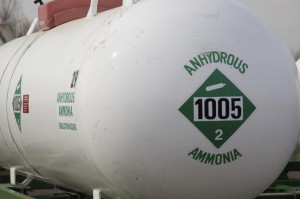Mechanical Integrity 101 | Ammonia Storage Tanks
 I was recently asked the following question:
I was recently asked the following question:
I work for a company that uses anhydrous ammonia for emission control. One thing that I noticed is there wasn’t any information on the tank maintenance (integrity testing of the tank etc). We have maintenance plans for all the components associated with the tank but do you know if there is a recommended maintenance for the tank itself?
Here was was my answer:
Great question! When ammonia is used in non-refrigeration applications such as emmission control, CGA G-2 and ANSI K61.1 CGA G-2.1 (published by the Compressed Gas Association) are the literature that describes Recognized and Generally Accepted Good Engineering Practice.
Section 18.14 of CGA G-2 outlines Maintenance and Periodic Inspection requirements for Stationary Ammonia Containers. I recommend that you obtain a copy of this document from the Compressed Gas Association. Section 18.14 includes the following subsections:
18.14.1 Maintenance
18.14.1.1 General
18.14.1.2 Repairs
18.14.1.3 Records
18.14.2 Periodic Inspection
18.14.2.1 Pressure Relief Valve
18.14.2.2 Container
18.14.2.3 Thickness Testing
18.14.2.4 Magnetic Particle Inspection
It is beyond the scope of this email to discuss each of these elements, but here are some highlights:
Section 18.14.1.1 “…The program must provide for the identification of potential problem areas including excessive corrosion; weakening of supports; reduction of container product retention integrity; deterioration of appurtenances; and leakage from container pressure relief devices, connections weld seams, valves and piping.”
Section 18.14.1.3 “Permanent and progressive records must be maintained by the owner of user of a storage container…”
Section 18.14.2.1 “As a minimum, every pressure relief valves must be given a visual external inspection each year.”
Section 18.14.2.2 “As a minimum, each storage container should be subjected to an external visual inspection at least once every year.”
Section 18.14.2.3 “…corroded or abraded areas in the shell or heads of a container must be thickness tested using suitable equipment and procedures. It is suggested that thickness measurements be made using an ultrasonic device…”
I can’t emphasize how important it is to find the correct RAGAGEP before deciding on the best maintenance practices. Each industry has nuances which must be considered before moving forward with a maintenance program.
 I was recently asked the following question:
I was recently asked the following question:
What verion of CGA G-2.1/ANSI K61.1 are you referencing for this inspection interval? All of the versions available to me (5th ed – 1999, 4th ed – 1989, 3rd ed – 1981 & 2nd ed – 1972) only have 13 sections. I haven’t been able to located any version that has a section 18. Is this from the 1st edition?
The reference from the blog come from CGA 2-1995.
Peter
When the safety pressure relief valve releases the ammonia vapour/gas from an ammonia’s storage tank to open atmosphere an environmental problem is created. In my opinion the release should be to a “capture storage” not to the open air. No such recommendation were published.
What is the recommended internal tank inspection? There is no mention in ANSI G-2.1-2014, which by the way does not have a section 18. Is there a sister std? I find no information on internal inspection requirements or recommendation for Best management Practice. If a sister tank had 55 gallons of sludge inside upon internal, would risk based judgement call for internal on the other tank? You thought appreciated.
You are correct that CGA G-2.1 – 2014 does not have Section 18. CGA G-2 and CGA G-2.1 are different documents. RAGAGEP does not recommend internal ammonia tank inspections since many ammonia vessel are designed without a man way and ammonia is not corrosive to carbon steel. API 510 does have recommendations/guidance for performing internal inspections of tanks (not specific to ammonia).
It makes sense how you said that there must be records kept about the maintenance the owner is doing on an ammonia tank. This would be really important in case someone else takes control of the tank and need to know if there are any potential problems. That or you could just hire a professional to take care of all the repairs for you.